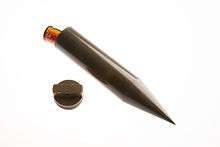Dead drop
A dead drop or dead letter box is a method of espionage tradecraft used to pass items or information between two individuals (e.g., a case officer and agent, or two agents) using a secret location, thus not requiring them to meet directly and thereby maintaining operational security. The method stands in contrast to the live drop, so-called because two persons meet to exchange items or information.
Overview
Spies (covert intelligence agents) and their handlers have been known to perform dead drops using various techniques to hide items (such as money, secrets or instructions), and to signal that the drop has been made. Although the signal and location by necessity must be agreed upon in advance, the signal may or may not be located close to the dead drop itself, and the operatives may not necessarily know one another or ever meet.
Considerations
The location and nature of the dead drop must enable retrieval of the hidden item without the operatives being spotted by a member of the public, the police, or other security forces—therefore, common everyday items and behavior are used to avoid arousing suspicion. Any hidden location could serve, although often a cut-out device is used, such as a loose brick in a wall, a (cut-out) library book, or a hole in a tree. In more modern times a dead drop could be an unsecured email server by which foreign agents can receive secret information digitally without ever being seen by the public. If the server is discovered the owner simply claims ignorance and is released rather than prosecuted for espionage.

The dead drop spike is a concealment device similar to a microcache. It has been used since the late 1960s to hide money, maps, documents, microfilm, and other items. The spike is water- and mildew-proof and can be pushed into the ground or placed in a shallow stream to be retrieved at a later time.
Signaling devices can include a chalk mark on a wall, a piece of chewing-gum on a lamppost, or a newspaper left on a park bench. Alternately, the signal can be made from inside the agent's own home, by, for example, hanging a distinctively-colored towel from a balcony, or placing a potted plant on a window sill where it is visible to anyone on the street. Convicted CIA mole and Soviet spy Aldrich Ames left chalk marks on a mail box in Washington, D.C. to signal his Russian handlers that he had made a dead drop.[1]
Drawbacks
While the dead drop method is useful in preventing the instantaneous capture of either an operative/handler pair or an entire espionage network, it is not foolproof. If one of the operatives is compromised, they may reveal the location and signal for that specific dead drop. Counterintelligence can then use the signal while keeping the location under surveillance, and may capture the other operative.
Modern techniques
On January 23, 2006, the Russian FSB accused Britain of using wireless dead drops concealed inside hollowed-out rocks to collect espionage information from agents in Russia. According to the Russian authorities, the agent delivering information would approach the rock and transmit data wirelessly into it from a hand-held device, and later his British handlers would pick up the stored data by similar means.[2]
See also
References
- ↑ "Aldrich Ames". Federal Bureau of Investigation. Retrieved 13 November 2016.
- ↑ Nick Paton Walsh, The Guardian (23 January 2006). "Moscow names British 'spies' in NGO row". Retrieved 8 April 2012.
Bibliography
- "Russians accuse 4 Britons of spying".International Herald Tribune. January 24, 2006. News report on Russian discovery of British "wireless dead drop".
- "Old spying lives on in new ways". BBC. 23 January 2006.
- Madrid suspects tied to e-mail ruse. International Herald Tribune. April 28, 2006.
- Military secrets missing on Ministry of Defence computer files
Further reading
| Look up dead drop in Wiktionary, the free dictionary. |
- Robert Wallace and H. Keith Melton, with Henry R. Schlesinger, Spycraft: The Secret History of the CIA's Spytechs, from Communism to al-Qaeda, New York, Dutton, 2008. ISBN 0-525-94980-1.